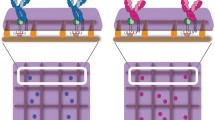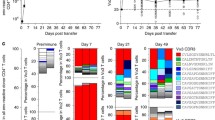Abstract
A model employing separate dose-dependent response functions for proliferation and differentiation of idiotypically interacting B cell clones is presented. For each clone the population dynamics of proliferating B cells, non-proliferating B cells and free antibodies are considered. An effective response function, which contains the total impact of proliferation and differentiation at the fixed points, is defined in order to enable an exact analysis. The analysis of the memory states is restricted in this paper to a two-species system. The conditions for the existence of locally stable steady states with expanded B cell and antibody populations are established for various combinations of different field-response functions (e.g. linear, saturation, log-bell functions). The stable fixed points are interpreted as memory states in terms of immunity and tolerance. It is proven that a combination of linear response functions for both proliferation and differentiation does not give rise to stable fixed points. However, due to competition between proliferation and differentiation saturation response functions are sufficient to obtain two memory states, provided proliferation preceeds differentiation and also saturates earlier. The use of log-bell-shaped response functions for both proliferation and differentiation gives rise to a “mexican-hat” effective response function and allows for multiple (four to six) memory states. Both a primary response and a much more pronounced secondary response are observed. The stability of the memory states is studied as a function of the parameters of the model. The attractors lose their stability when the mean residence time of antibodies in the system is much longer than the B cells' lifetime. Neither the stability results nor the dynamics are qualitatively chanbed by the existence of non-proliferating B cells: memory states can exist and be stable without non-proliferating B cells. Nevertheless, the activation of non-proliferating B cells and the competition between proliferation and differentiation enlarge the parameter regime for which stable attractors are found. In addition, it is shown that a separate activation step from virgin to active B cells renders the virgin state stable for any choice of biologically reasonable parameters.
Similar content being viewed by others
Literature
Behn, U. and J. L. van Hemmen. 1989a. Network description of the immune system: Dormant B cells stabilize cycles.J. Stat. Phys. 56, 533–545.
Behn, U. and J. L. van Hemmen. 1989b. On the theory of networks for the immune system. In:Dynamical Networks. W. Ebeling and M. Peschel (Eds.), pp. 162–172. Berlin: Academic Verlag.
Behn, U., J. L. van Hemmen and B. Sulzer. 1992. Memory B cells stabilize cycles in a repressive network. InTheoretical and Experimental Insight into Immunology. A. S. Perelson, G. Weisbuch and A. Coutinho (Eds), pp. 249–260. Berlin: Springer.
Behn, U., J. L. van Hemmen and B. Sulzer. 1993. Memory to antigenic challenge of the immune system: Synergy of idiotypic interactions and memory B cells.J. theor. Biol., in press.
Bell, G. 1970. Mathematical model of clonal selection and antibody production.J. theor. Biol. 29, 191–232.
Bell, G. 1971. Mathematical model of clonal selection and antibody production. II–III.J. theor. Biol. 33, 339–398.
Coutinho, A. 1989. Beyond clonal selection and network.Immunol. Rev. 110, 63–87.
De Boer, R. J. 1983. GRIND. Great Integrator Differential Equations, Bioinformatics Group, University of Utrecht, The Netherlands
De Boer, R. J. and P. Hogeweg. 1989a. Memory but no suppression in low-dimensional symmetric idiotypic networks.Bull. math. Biol. 51, 223–246.
De Boer, R. J. and P. Hogeweg. 1989b. Unreasonable implications of reasonable idiotypic network assumptions.Bull. math. Biol. 51, 381–408.
De Boer, R. J., I. G. Kevrekidis and A. S. Perelson. 1990. A simple idiotypic network model with complex dynamics.Chem. Engng Sci. 45, 2375–2382.
De Boer, R. J., A. U. Neumann, A. S. Perelson, L. A. Segel and G. Weisbuch. 1992. Recent approaches to immune networks. Santa Fe Institute Working Papers Series, 91-10-040.
De Boer, R. J., I. G. Kevrekidis and A. S. Perelson. 1993a. Immune network behavior I: From stationary states to limit cycle oscillations.Bull. math. Biol. 55, 745–780.
De Boer, R. J., I. G. Kevrekidis and A. S. Perelson. 1993b. Immune network behavior II: From oscillations to chaos and stationary states.Bull. Math. Biol. 55, 781–816.
Goldstein, B. 1988. Desensitization, histamine release and the aggregation of IgE on human basophiles. In:Theoretical Immunology, Part Two,SFI Studies in the Science of Complexity. A. S. Perelson (Ed.), Vol. III, pp. 3–40, Redwood City, CA: Addison-Wesley.
Gray, D. and T. Leanderson. 1990. Expansion, selection and maintenance of memory B-cell clones. In:Immunological Memory, Current Topics in Microbiol. and Immunol. D. Gray and J. Sprent (Eds), Vol. 159, pp. 1–17.
Grossman, Z., R. Asofsky and C. DeLisi. 1980. The dynamics of antibody secreting cell production: Regulation of growth and oscillations in the response to T-independent antigens.J. theor. Biol. 84, 49–92.
Hoffmann, G. W. 1975. A theory of regulation and self-nonself discrimination in an immune network.Eur. J. Immunol. 5, 638–647.
Jerne, N. K. 1974. Towards a net work theory of the immune system.Ann. Immunol. (Inst. Pasteur) 125C, 373–389.
Jerne, N. K. 1984. Idiotypic networks and other preconceived ideas.Immunol. Rev. 79, 5–24.
Jerne, N. K. 1985. The generative grammar of the immune system.EMBO J. 4, 243–247.
Linton, J.-P., D. J. Decker and N. R. Klinman. 1989. Primary antibody-forming cells and secondary B cells are generated from separate precursor cell populations.Cell 59, 1049–1059.
Merrill, S. J. 1978. A model of the stimulation of B-cells by replicating antigen.Math. Biosci. 41, 125.
Murray, J. D. 1989.Mathematical Biology, pp. 702–705. Berlin: Springer.
Neumann, A. U. and G. Weisbuch. 1992a. Window automata analysis of population dynamics of the immune system.Bull. math. Biol. 54, 21–44.
Neumann, A. U. and G. Weisbuch. 1992b. Dynamics and topology of immune networks.Bull. math. Biol. 54, 699–726.
Perelson, A. S. 1988. Theoretical Immunology, Part Two,SFI Studies in the Science of Complexity. A. S. Perelson (Ed.), Vol. III, Redwood City, CA: Addison-Wesley.
Perelson, A. S. 1989. Immune network theory.Immunol. Rev. 110, 5–36.
Perelson, A. S. and C. DeLisi. 1980. Receptor clustering on a cell surface. I. Theory of receptor cross-linking by ligands bearing two chemically identical functional groups.Math. Biosci. 48, 71–110.
Perelson, A. S., M. Mirmirani, G. F. Oster. 1976. Optimal strategies in immunology. I. B-cell differentiation and proliferation.J. math. Biol. 3, 325–367.
Prikrylová, D., M. Jilek and J. Waniewski. 1992.Mathematical Modeling of the Immune Response, pp. 91–112. Boca Raton, FL: CRC Press.
Rasure, J. and M. Young. 1992. An open environment for image processing software development. In:SPIE Proceedings, Vol. 1659.
Richter, P. H. 1975. A network theory of the immune system.Eur. J. Immunol. 5, 350–354.
Richter, P. H. 1978. The network idea and the immune response. In:Theoretical Immunology. G. I. Bell, A. S. Perelson and G. H. Pimbley (Eds), pp. 539–569. New York: Marcel Dekker.
Schittek, B. and K. Rajewski. 1990. Maintenance of B-cell memory by long-lived cells generated from proliferating precursors.Nature 346, 749–752.
Segel, L. A. and A. S. Perelson. 1990. Some reflections on memory in shape space. In:Theories of Immune Networks. H. Atlan and I. R. Cohen (Eds.), pp. 63–70. Berlin, Springer.
Segel, L. A. and A. S. Perelson. 1991. Exploiting the diversity of time scales in the immune system: A B-cell antibody model.J. stat. Phys. 63, 1113–1131.
Varela, F. J. and A. Coutinho. 1991. Second generation immune networks.Immunol. Today 12, 159–166.
Varela, F. J. and J. Stewart. 1990. Dynamics of a class of immune networks: Global stability of idiotype interactions.J. theor. Biol. 144, 93–101.
Vitetta, E. S., M. T. Berton, C. Burger, M. Kepron, W. T. Lee and X.-M. Yin. 1991. Memory B and T cells.Ann. Rev. Immunol. 9, 193–217.
Weisbuch, G., R. J. de Boer and A. S. Perelson. 1990. Localized memory in idiotypic networks.J. theor. Biol. 146, 483–499.
Author information
Authors and Affiliations
Rights and permissions
About this article
Cite this article
Sulzer, B., Leo van Hemmen, J., Neumann, A.U. et al. Memory in idiotypic networks due to competition between proliferation and differentiation. Bltn Mathcal Biology 55, 1133–1182 (1993). https://doi.org/10.1007/BF02460702
Received:
Revised:
Issue Date:
DOI: https://doi.org/10.1007/BF02460702




